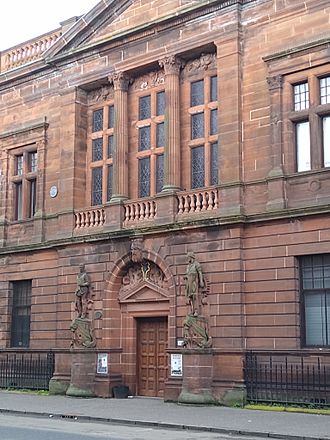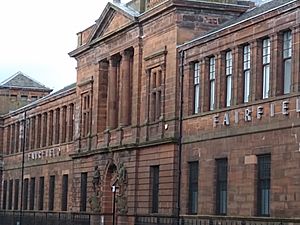Fairfield Offices facts for kids
Quick facts for kids Fairfield Heritage Centre |
|
|---|---|

Fairfield Offices main entrance on Govan Road
|
|
| General information | |
| Type | Shipyard drawing office |
| Architectural style | Italian Renaiassance Revival |
| Address | 1048 Govan Road G51 4XS |
| Town or city | Glasgow |
| Country | Scotland |
| Construction started | 1888 |
| Completed | 1891 |
| Renovated | 2013 |
| Renovation cost | £5.8 million |
| Client | Fairfield Shipbuilding and Engineering Company |
| Owner | Govan Workspace Ltd. |
| Design and construction | |
| Architect | John Keppie |
| Architecture firm | Honeyman and Keppie |
| Developer | Sir William Pearce, 1st Baronet |
| Other designers | Charles Rennie Mackintosh (assistant) James Pittendrigh Macgillivray (sculptor) |
| Renovating team | |
| Architect | Page\Park Architects |
|
Listed Building – Category A
|
|
| Designated | 15 December 1970 |
| Reference no. | LB33356 |
The Fairfield Heritage Centre is located on Govan Road in Glasgow, Scotland. This building was once the main office for a large company called Fairfield Shipbuilding and Engineering Co Ltd. It was built between 1889 and 1891.
For many years, the building served as the main office for different companies that owned the shipyard next door. In 2001, the last company, BAE Systems Marine, moved out. The building was then empty for eight years and started to fall apart.
In 2009, a charity called Govan Workspace bought the building. They spent over £5.8 million to fix it up and bring it back to life. In 2013, it reopened as a heritage centre and also has modern offices for businesses.
Contents
Exploring the Heritage Centre
The Fairfield Heritage Centre lets you explore important parts of the old office building. You can see the former boardroom, where big decisions were made, and the management offices. There's also the directors' dining room, plus the main entrance and lobby.
The first floor used to be the drawing offices, where engineers created plans for ships. Now, this area has 18,000 square meters of modern office spaces. The ground floor, once the counting house, also has new offices.
What You'll See and Learn
The heritage area is free to visit and is open seven days a week from 1pm to 4pm. It tells the amazing story of over 150 years of shipbuilding at the yard. You'll find real objects, colorful display panels, and interactive screens. There are also videos and audio presentations to help you learn.
The exhibits cover many interesting topics. You can learn about new inventions in shipbuilding and the race to build the fastest ships to win the Blue Riband for Atlantic crossings. The centre also covers the shipyard's role in the two World Wars.
You'll also discover the "Fairfield Experiment" from the 1960s, which was a new way of managing workers. The story continues through the eras of Upper Clyde Shipbuilders, Govan Shipbuilders, and Kvaerner Govan. In 2006, BAE Systems launched the 750th ship built at Fairfield!
Finding the Centre
The Fairfield Heritage Centre is on Govan Road in Glasgow. It's right across from Elder Park. It's also very close to other landmarks: about 200 meters west of the Pearce Institute and 300 meters west of Govan subway station and the bus interchange.
A Look Back at History
When the Fairfield offices were built, the shipyard was one of the most important on the River Clyde. This was clear at the first Glasgow Exhibition in 1888, where Fairfield had a big display.
Some of the first special events held in these offices were parties to celebrate the launch of two famous Cunard liners: the Campania in 1892 and the Lucania in 1893. These were very fast ships!
Who Designed the Building?
The building was designed by an architecture firm called Honeyman and Keppie. This firm was located at 140 Bath Street in Glasgow at the time. Today, the company still exists as Keppie Design and is now based at 160 West Regent Street.
It is believed that John Keppie was the main designer of the Fairfield offices. Interestingly, Charles Rennie Mackintosh, a very famous Scottish architect, was a junior staff member at the firm starting in 1888. He is thought to have worked on this project too.
The Visionary Behind Fairfield
The offices were built for the Fairfield Shipbuilding and Engineering Co. Ltd.. The person who really pushed for these new offices was Sir William Pearce. His painting still hangs in the boardroom today.
Sir William Pearce became the sole owner of the business in 1878. He was also a local Member of Parliament from 1886. Sadly, he passed away before the new offices were completely finished.
Pearce changed the company's name from Randolph Elder and Co. to Fairfield Shipbuilding and Engineering Co. Ltd. in 1885. He named it after the former farm where the shipyard was built. He reorganized the company so it could compete for contracts to build ships for the navy.
Fairfield's Philanthropic Spirit
Sir William Pearce was a kind person who cared about his community. He paid for the nearby Pearce Institute, which helped local people.
Isabella Elder, who used to own the shipyard with her husband John Elder, was also very generous. She paid for the nearby Elder Park, which was designed by John Honeyman.
Architectural Details
The building was designed to be useful for work and also to impress important visitors and potential clients. It has many features from the Italianate and Beaux Arts styles, which were popular at the time. You can also spot some Art Deco details that were added later.
Inside, there were large, bright rooms for the draughtsmen. These skilled workers created detailed drawings for both shipbuilding and engineering projects. The building is considered very important and is protected as a Category A listed building.
John Keppie, the lead designer, studied architecture in Paris in the 1880s. While it was likely Honeyman who secured the project because of his past work with the Elder family, Keppie led the design. On the outside of the main entrance, you can see sculptures of a shipwright (a ship builder) and an engineer. These were created by a Glasgow sculptor named James Pittendreigh Macgillivray, who also worked with Keppie on other projects.


